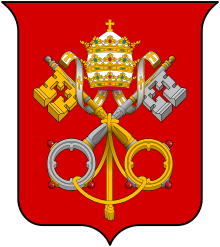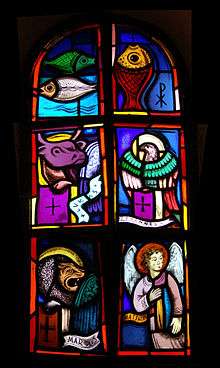Pope Agatho
| Pope Saint Agatho | |
|---|---|
 | |
| Papacy began | 27 June 678 |
| Papacy ended | 10 January 681 |
| Predecessor | Donus |
| Successor | Leo II |
| Personal details | |
| Birth name | Agatho |
| Born |
c. late 6th century Unknown, possibly Province of Sicily, Eastern Roman Empire |
| Died |
10 January 681 Rome, Exarchate of Ravenna, Eastern Roman Empire |
| Sainthood | |
| Feast day |
|
| Venerated in | |
| Attributes | Holding a long cross |
| Patronage | Palermo |
Pope Agatho (died 10 January 681 AD) served as the Pope from 26 June 678 until his death in 681.[1] He is venerated as a saint by both the Roman Catholic and Eastern Orthodox Churches.
Life
Little is known of Agatho before his papacy but he may have been among the many Sicilian clergy in Rome at that time, due to the Islamic Caliphate battles against Sicily in the mid-7th century.[2] He served several years as treasurer of the church of Rome. He succeeded Donus in the pontificate in 679.[3]
Papacy
Shortly after Agatho became Pope, St Wilfrid, Archbishop of York, arrived in Rome to invoke the authority of the Holy See on his behalf. Wilfrid had been deposed from his see by Theodore, Archbishop of Canterbury, who had carved up Wilfrid's diocese and appointed three bishops to govern the new sees. At a synod which Pope Agatho convoked in the Lateran to investigate the affair, it was decided that Wilfrid's diocese should indeed be divided, but that Wilfrid himself should name the bishops.[4]
The major event of his pontificate was the Sixth Ecumenical Council (680–681), following the end of the Muslim Siege of Constantinople,[5] which suppressed the Monothelite heresy that had been tolerated by previous popes (Honorius among them). The council began when Emperor Constantine IV, wanting to heal the schism that separated the two sides, wrote to Pope Donus suggesting a conference on the matter, but Donus was dead by the time the letter arrived. Agatho was quick to seize the olive branch offered by the Emperor. He ordered councils held throughout the West so that legates could present the universal tradition of the Western Church. Then he sent a large delegation to meet the Easterners at Constantinople.[4]
.jpg)
The legates and patriarchs gathered in the imperial palace on 7 November 680. The Monothelites presented their case. Then a letter of Pope Agatho was read that explained the traditional belief of the Church that Christ was of two wills, divine and human. Patriarch George of Constantinople accepted Agatho's letter, as did most of the bishops present. The council proclaimed the existence of the two wills in Christ and condemned Monothelitism, with Pope Honorius being included in the condemnation. When the council ended in September 681 the decrees were sent to the Pope, but Agatho had died in January. The Council had not only ended the Monothelite heresy, but also had healed the schism.[4]
Agatho also undertook negotiations between the Holy See and Constantine IV concerning the interference of the Byzantine Court to papal elections. Constantine promised Agatho to abolish or reduce the tax that the popes had to pay to the imperial treasury on their consecration.[4]
Veneration
Anastatius says, that the number of his miracles procured him the title of Thaumaturgus. He died in 682, having held the pontificate two years and a half years.[3] He is venerated as a saint by both Roman Catholics and Eastern Orthodox.[1] His feast day among Roman Catholics is on 10 January.[6] Eastern Christians, including Eastern Orthodox and the Eastern Catholic Churches, commemorate him on 20 February.[7]
See also
References
| Wikisource has the text of the 1913 Catholic Encyclopedia article Pope St. Agatho. |
- 1 2
 Herbermann, Charles, ed. (1913). "Pope St. Agatho". Catholic Encyclopedia. New York: Robert Appleton Company.
Herbermann, Charles, ed. (1913). "Pope St. Agatho". Catholic Encyclopedia. New York: Robert Appleton Company. - ↑ Jeffrey Richards (1 May 2014). The Popes and the Papacy in the Early Middle Ages: 476-752. Routledge. p. 270. ISBN 9781317678175.
- 1 2 Butler, Alban. "St. Agatho, Pope", The Lives of the Saints, Vol. I, 1866. Butler spells the name of Agatho's predecessor as "Domnus"; according to "Pope Donus" in the Catholic Encyclopedia", this is an alternative spelling of "Donus".
- 1 2 3 4 Joseph Brusher, S.J., Popes Through the Ages.
- ↑ Hubert Cunliffe-Jones (24 Apr 2006). A History of Christian Doctrine (reprint ed.). A&C Black. p. 233. ISBN 9780567043931.
- ↑ Martyrologium Romanum
- ↑ Orthodox Church in America
| Catholic Church titles | ||
|---|---|---|
| Preceded by Donus |
Pope 678–681 |
Succeeded by Leo II |

